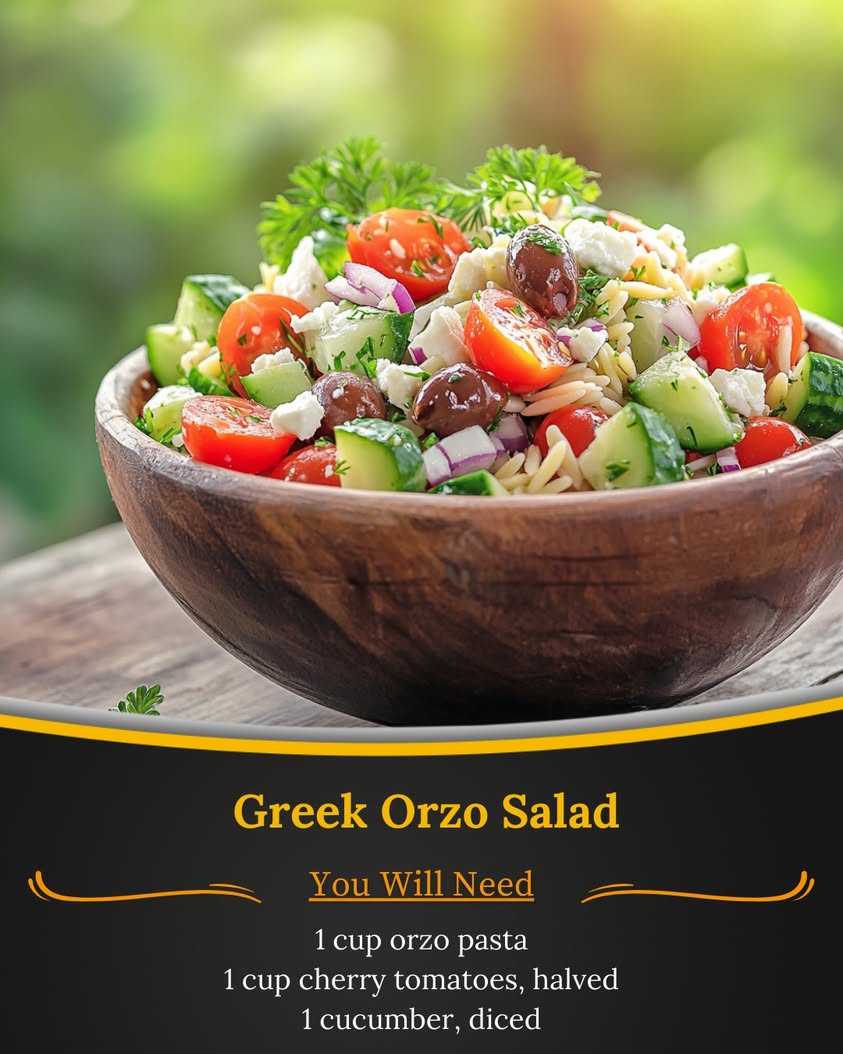Delicious Greek Orzo Salad: A Fresh Mediterranean Delight

Delicious Greek Orzo Salad: A Refreshing Mediterranean Delight
Greek Orzo Salad is a vibrant and refreshing dish that captures the essence of Mediterranean flavors, making it a perfect choice for any meal. The combination of orzo pasta, fresh vegetables, and flavorful herbs creates a delightful harmony of textures and tastes. Ideal for a light lunch, a picnic feast, or as a side to grilled meats, this salad showcases the best of Greek cuisine in a simple and accessible way.
With its bright colors and crisp ingredients, Greek Orzo Salad is also a feast for the eyes. The freshness of diced cucumbers, ripe tomatoes, Kalamata olives, and a generous sprinkle of feta cheese elevates every bite. Combined with a lemony dressing and fragrant herbs, this dish not only satisfies your palate but also gives a boost of healthy goodness, making it a favorite among health enthusiasts and food lovers alike.
Quick Recipe Highlights
- Flavor Profile: The combination of lemon juice, olive oil, and fresh herbs creates a tangy and aromatic dressing that complements the sweet and crunchy vegetables.
- Texture: The salad features a variety of textures, from the chewiness of orzo to the crunch of cucumbers and the creaminess of feta cheese, resulting in a satisfying mouthfeel.
- Aroma: The refreshing scent of mint and parsley combined with the zesty lemon dressing fills the air, inviting you to dig in.
- Visual Appeal: This salad bursts with vibrant colors – bright greens, deep reds, and creamy whites – making it visually stunning for any gathering.
- Skill Level Needed: This recipe is suitable for beginners, requiring only basic chopping and mixing skills.
- Special Equipment: A large mixing bowl and a kitchen knife are all you need for this easy salad preparation.
Recipe Overview
- Difficulty Level: This Greek Orzo Salad is easy to prepare, making it great for first-time cooks or anyone looking for a quick meal solution.
- Category: This dish can be served as a light main course or as a side dish, perfect for picnics, barbecues, or potlucks.
- Cuisine: Rooted in Greek culinary traditions, this salad reflects the region’s emphasis on fresh ingredients, olive oil, and bright flavors.
- Cost: Ingredients like orzo, vegetables, and feta cheese are generally affordable, making this dish cost-effective for feeding a crowd.
- Season: Ideal for warm months when fresh vegetables are plentiful, this salad remains delightful year-round, especially when paired with seasonal herbs.
- Occasion: Perfect for casual gatherings, summer barbecues, and even as a make-ahead meal for busy weeknights.
Why You’ll Love This Recipe
Greek Orzo Salad is sensational not only for its fresh taste but also because of the multitude of benefits it offers. The vibrant blend of flavors creates a wonderful taste experience that appeals to everyone. This dish features the earthy taste of olive oil and the bright essence of lemon, harmonizing perfectly with the refreshing crunch of cucumbers and the sweetness of cherry tomatoes. Each bite feels like a celebration of summer in the Mediterranean.
Convenience also plays a crucial role in why this Greek Orzo Salad is beloved by many. The simplicity of preparation allows you to whip it up in mere minutes—perfect for a quick lunch or dinner. This dish can be prepared in advance, stored in the fridge, and served cold, making it an ideal choice for meal preps. With the option to customize ingredients, you can easily adapt the recipe to suit personal preferences and dietary restrictions, adding or exchanging vegetables or proteins as desired.
From a nutritional standpoint, Greek Orzo Salad packs a substantial punch. Orzo provides carbohydrates for energy, while fresh vegetables contribute essential vitamins and fibers that promote health and well-being. Feta cheese adds a source of protein and calcium, making this salad not only delicious but also a balanced meal boasting nutritional benefits. Enjoying this salad regularly could enhance your overall diet and lead to a rejuvenated lifestyle.
Moreover, this Greek Orzo Salad is a crowd-pleaser, making it a staple dish for social gatherings and summer events. Whether served on the patio during a barbecue or brought to a potluck, it always garners compliments and brings people together. This combination of great taste and the joy it spreads among friends and family is what makes it a cherished recipe in many households.
Finally, the cost-effectiveness and accessibility of ingredients make this salad an easy choice for everyone. Most of the components can be found in local grocery stores, with many of them being staples in your kitchen. This accessibility ensures that preparing a delicious and healthy meal is never a hassle, equipping you with a fantastic recipe that can be enjoyed on any occasion.
Historical Background and Cultural Significance
Greek Orzo Salad holds historical significance as a reflection of Greek culinary traditions that emphasize fresh, wholesome ingredients. Orzo, a rice-shaped pasta, finds its origins in Italian cuisine but has seamlessly integrated into Greek dishes, adapting to local flavors and styles. The salad embodies a blend of cultural influences that celebrate the Mediterranean lifestyle rooted in communal dining and shared meals.
Culturally, this salad represents the essence of Greek hospitality, or “philoxenia,” where sharing delicious homemade food with family and friends is part of life’s traditions. Greek cuisine often highlights the use of seasonal ingredients that thrive in the Mediterranean climate, showcasing vibrant vegetables and aromatic herbs. Such practices contribute to the shared history of not just the recipes, but also the people and their connections.
The evolution of Greek Orzo Salad is fascinating, as it has transformed from a simple side dish into a versatile and beloved component of meals globally. As culinary trends embrace health-focused eating and international flavors, the salad has gained popularity beyond Greek borders, becoming a favorite in various cuisines. This evolution reflects ongoing shifts in dining culture and preferences.
Regional variations show the salad’s adaptability, with countless interpretations incorporating local ingredients and dietary practices. In some areas, you’ll find it enriched with grilled meats, while others may include seasonal herbs or additional spices. This versatility highlights the unique identities and flavors that reflect local communities while maintaining the roots of its Greek origins.
Ingredient Deep Dive
Orzo: This rice-shaped pasta is a popular staple in Mediterranean cooking. Its versatility allows it to be used in various salads, soups, and casseroles. Nutritionally, orzo is made primarily of wheat and contains carbohydrates that serve as a good energy source. When shopping for orzo, look for whole grain orzo for additional fiber and nutrients. Store orzo in a cool, dry place, and consider substituting it with quinoa or gluten-free pasta for different dietary needs.
Feta Cheese: Feta cheese is a traditional Greek cheese made from sheep’s milk or a mixture of sheep and goat milk. Its distinct salty and tangy flavor profiles complement many dishes, especially salads. Feta provides protein and calcium, making it a nutritious addition to your meals. When selecting feta, opt for those stored in brine for maximum freshness and quality. For a less salty option, try using ricotta or goat cheese as an alternative.
Cucumbers: Fresh cucumbers are a vital ingredient that adds crunch and hydration to the salad. Known for their high water content, cucumbers offer numerous health benefits, including aiding in digestion and providing vitamins. Always choose firm, shiny cucumbers and store them in the refrigerator to maintain freshness. For a twist, consider pickling cucumbers or substituting with bell peppers for a different flavor profile.
Kalamata Olives: These dark purple olives are native to Greece and provide a briny richness that contrasts well with other ingredients. Known for heart-healthy fats, kalamata olives contribute antioxidants and anti-inflammatory properties. When choosing olives, look for those stored in oil or brine for better flavor. For a taste variation, use green olives or olives of different varieties to create a unique twist on your salad.
Common Mistakes to Avoid
- Overcooking the Orzo: Ensure the orzo is cooked al dente to maintain the perfect chewy texture; always follow cooking times on the package.
- Neglecting to Drain: After boiling, fully drain the orzo to prevent excess water from making the salad soggy.
- Too Much Dressing: Start with a small amount of dressing and add more as needed to avoid overpowering the salad’s flavors.
- Inadequate Cooling: Allow the orzo to cool before combining it with fresh vegetables; this prevents wilting and maintains crispness.
- Forgetting Seasoning: Always taste your salad before serving; a pinch of salt or an extra squeeze of lemon can elevate flavors significantly.
- Skipping Herbs: Fresh herbs make a difference; don’t omit them as they add crucial flavor and freshness to the salad.
- Using Old Ingredients: Fresh produce is key; always select high-quality ingredients for the best flavor and texture.
- Not Allowing Time to Marinate: Letting the salad rest before serving allows flavors to meld, enhancing the overall taste experience.
Essential Techniques
Proper Cooking of Orzo: To achieve the ideal al dente texture, boil the orzo in salted water until just tender, typically about 8-10 minutes. Be sure to test it a minute or two before the recommended cooking time. Drain promptly and rinse under cold water to halt the cooking process and prevent sticking. This technique is essential for a perfect texture that compliments other salad ingredients.
Balancing Flavors: Achieving balance in salads is crucial for an enjoyable dining experience. Use a 3:1 ratio of oil to vinegar in your dressing and adjust with salt, pepper, and spices. Tasting continuously allows you to master the flavor profile and make necessary adjustments. A well-balanced dressing enhances the salad without overwhelming natural flavors.
Pro Tips for Perfect Greek Orzo Salad
1. **Chill Before Serving**: Refrigerate the salad for at least 30 minutes. This time allows the flavors to develop, making every bite more satisfying.
2. **Experiment with Add-Ins**: Try adding grilled chicken, shrimp, or chickpeas for protein, boosting nutritional value while adding substance.
3. **Use Seasonal Vegetables**: Incorporate seasonal vegetables for the freshest flavor; zucchini, bell peppers, or roasted vegetables are excellent choices.
4. **Dress Right Before Serving**: For maximum crispiness, add dressing immediately before serving to prevent wilting of fresh veggies.
5. **Zest for Extra Flavor**: Adding lemon zest to the dressing can elevate the flavor profile without adding more acidity.
6. **Garnish Generously**: Garnish with extra feta, olives, or fresh herb sprigs for a visually appealing presentation that invites everyone to dig in.
Variations and Adaptations
This Greek Orzo Salad offers numerous variations, allowing for customization based on taste preferences and dietary restrictions. You can experiment with different types of seasonal vegetables, such as asparagus in spring or roasted butternut squash in fall, for a seasonal twist. For those seeking heartier options, consider adding grilled chicken or chickpeas to provide protein and make it more filling.
For a Mediterranean flair, try incorporating artichoke hearts, sun-dried tomatoes, or spinach, which add additional flavors and textures. If you prefer a creamier salad, mix in some Greek yogurt, creating a new dressing alternative that maintains the Mediterranean essence while providing a smooth and rich mouthfeel.
In terms of dietary modifications, for gluten-free options, swap orzo for quinoa or brown rice. You can also create a vegan version by omitting feta and using nutritional yeast for a cheesy flavor. Keeping it fresh and adaptable ensures that your Greek Orzo Salad remains a favorite across all sorts of dietary needs and occasions.
Serving and Presentation Guide
The presentation of Greek Orzo Salad starts with beautiful plating techniques. Use a large, shallow bowl to showcase the vibrant colors and textures of the ingredients. Employ a spoon to gently mound the salad in the center, leaving space around the edges for garnishes. A sprinkle of paprika or a drizzle of olive oil can add an appealing finish to the dish.
Garnish with fresh herbs and a wedge of lemon for an inviting and enticing appearance, encouraging guests to help themselves. Traditional accompaniments often include grilled meats or pita bread, which pair beautifully with the flavors of the salad. Serving it at cooler temperatures enhances the refreshing qualities, making it ideal for warm weather dining.
Consider portion control by serving in smaller bowls, ensuring guests can partake without overindulging. This also encourages second servings, allowing everyone to enjoy the salad’s deliciousness more than once!
Wine and Beverage Pairing
Pairing wine with Greek Orzo Salad enhances the dining experience. A crisp, chilled Sauvignon Blanc or a light-bodied Pinot Grigio complements the fresh vegetables and bright vinaigrette beautifully. For a red option, consider a light-bodied Grenache or a fruity Merlot that balances the feta and olives without overwhelming the dish’s flavors.
For non-alcoholic alternatives, sparkling water infused with a squeeze of lemon or fresh mint offers a refreshing and festive feel. If coffee or tea fits into your meal, opt for herbal teas that bring aromatic notes complementing the salad’s ingredients. Remember to serve beverages cold alongside the salad to maintain a light and refreshing atmosphere.
Storage and Shelf Life
To ensure your Greek Orzo Salad remains fresh, store it in an airtight container in the refrigerator. Proper storage methods keep ingredients crisp and prevent spoilage. When stored correctly, the salad can last about 3-4 days, although it is best to enjoy within the first couple of days for maximum flavor and texture.
When reheating, consider doing so on low heat to avoid overcooking the pasta or vegetables. Alternatively, you can enjoy it cold as a refreshing dish that is both delicious and convenient. Signs of spoilage include a sour smell or discoloration of the vegetables; when in doubt, it’s best to err on the side of caution.
If you wish to freeze the salad, be mindful that some ingredients may lose their texture upon thawing, particularly cucumbers and tomatoes. It’s better to freeze just the orzo and dressing separately, combining them with fresh ingredients upon thawing for an optimum experience.
Make Ahead Strategies
This Greek Orzo Salad is ideal for make-ahead strategies, allowing for easy meal prep and planning. Prepare the orzo and dressing in advance, storing them separately until you’re ready to serve. Fresh vegetables may reduce their crispness, so it’s best to chop those shortly before serving time. This approach maintains optimal freshness.
When planning a gathering, consider preparing the salad a day in advance; just remember to wait until serving to add delicate ingredients like cucumbers and feta to ensure they stay crisp and flavorful. Fresh herbs can also be mixed in at the last minute to preserve their vibrant color and aroma.
For best practices, assemble components a few hours prior to serving if time permits. The allowed resting period increases flavor integration and enhances the overall dish, making it even more enjoyable for guests. Fresh additions like avocados or nuts can be added right before serving, adding new textures without compromising quality.
Scaling Instructions
When it comes to scaling the Greek Orzo Salad recipe, binary adjustments make the process simple. Halving the recipe works effortlessly when dining with fewer people—just use half the quantity of each ingredient, maintaining the same ratios for dressings and seasonings.
For larger gatherings, doubling or tripling the recipe is just as easy. Depending on quantities, consider larger bowls for mixing and additional storage containers. Timing may need adjustments for cooking or prepping multiple batches, so have a keen eye on the orzo as it cooks.
In scaling, larger quantities will generally require more dressing to maintain proper flavor balance. It’s prudent to mix dressing in increments, always tasting as you go to achieve the desired flavor without overwhelming the other ingredients. Storing excess portions may require more substantial containers, ensuring the salad remains fresh for future meals.
Nutritional Deep Dive
Greek Orzo Salad offers a healthy balance of macronutrients that contribute to a balanced diet. Each serving typically contains carbohydrates from orzo, protein from feta, and healthy fats from olive oil and olives. Together, these components create a satisfying meal that provides lasting energy.
Micronutrient analysis reveals that this salad is rich in vitamins A, C, and K from the vegetables, as well as calcium and phosphorus from the feta. These vitamins contribute to valuable health benefits, including improved immunity, skin health, and bone strength. Including various colors from different vegetables increases the spectrum of nutrients and benefits received.
From a dietary perspective, this salad is versatile and can accommodate various preferences, making it suitable for different meal plans. Adjust portion sizes based on individual dietary needs—larger portions for higher energy needs or smaller servings for lighter meals maintain flexibility with this dish.
Incorporating Greek Orzo Salad into regular meals can be beneficial in weight management plans, as it prioritizes vegetables and whole grains. With low-calorie ingredients and high fiber content, it encourages satiety while providing essential nutrients without excessive calories.
Dietary Adaptations
Adapting Greek Orzo Salad to fit specific diets is a breeze. For gluten-free diets, substitute orzo with quinoa, brown rice, or gluten-free pasta options. Each alternative offers unique textures while allowing everyone to enjoy the salad’s flavors.
For a vegan version, omit feta and incorporate nutritional yeast for a cheesy flavor, or replace it with a creamy avocado to achieve a luscious texture. Consider swapping honey in the dressing with agave syrup to make it suitable for vegans.
Dairy-free adaptations can be made by using alternatives like cashew cream or coconut yogurt in place of feta. Additionally, keeping the dish paleo-friendly requires swapping out orzo for spiralized vegetables or cauliflower rice while maintaining the salad base.
Other diets like keto can benefit from lower carb substitutes like diced zucchini or bell peppers instead of orzo. Each of these adaptations maintains the essence of Greek Orzo Salad while catering to individual needs and preferences.
Troubleshooting Guide
If your Greek Orzo Salad doesn’t meet expectations, it’s helpful to troubleshoot various elements. Texture issues may arise if orzo is overcooked; ensure you follow cooking instructions and test regularly. If ingredients become mushy, consider undercooking slightly for a more desirable texture.
Flavor balance is crucial—if the salad tastes bland, try adding more salt, acid, or even a bit of sugar to round out flavors. Fresh herbs can help brighten the dish and improve overall taste when added right before serving.
Temperature problems can affect salad enjoyment; if served too cold, let it sit out for a few minutes to reach an optimal temperature. Equipment challenges often include not having the suitable bowls for mixing; a large mixing bowl makes combining ingredients easier.
For ingredient substitutions or timing concerns, always aim for similar textures. Mixing in appropriate substitutes when necessary ensures that expectations are met, but remember to adjust seasoning accordingly.
Recipe Success Stories
Readers of Greek Orzo Salad have shared their success stories, often highlighting how this dish has become a favorite at gatherings. Many have noted the ease of preparation, allowing them to focus on entertaining instead of stressing over complicated recipes. The versatility of the salad encourages creativity in ingredient use, leading to numerous variations that maintain the essence of the original.
Community members frequently discuss adaptations they’ve made based on personal preferences, showcasing the adaptability of the salad for various dietary needs. Particularly, those who’ve tried vegan versions have described using creative substitutes that still captured the flavor profile their families love.
Photography tips shared by users indicate that plating the salad in vibrant dishes enhances its visual appeal, inviting all to savor its beauty. The social media engagement around the recipe highlights a sense of community, where people bond over food, sharing their twists and celebrating culinary creativity.
Inviting feedback inspires many to explore new flavor combinations or enhance presentation techniques, making Greek Orzo Salad more than just a dish—it’s a gateway for culinary exploration and connection amongst friends and family.
Frequently Asked Questions
Can I make Greek Orzo Salad in advance?
Absolutely! Greek Orzo Salad can be prepared a day ahead of time. Just remember to add fresh ingredients like cucumbers and herbs right before serving to keep them crisp and vibrant.
What if I don’t have orzo?
If orzo isn’t available, you can substitute it with quinoa, couscous, or even rice. Each option will bring a unique texture to your salad while keeping it delicious.
How long does Greek Orzo Salad last in the fridge?
When stored in an airtight container, Greek Orzo Salad can last for about 3-4 days in the refrigerator. However, it’s best eaten fresh within the first couple of days for optimal flavor and texture.
Can I freeze Greek Orzo Salad?
While you can freeze the orzo itself, it’s not advisable to freeze the entire salad with fresh vegetables as they may lose their texture. Instead, store the components separately and assemble when ready to eat.
What dressing works best for Greek Orzo Salad?
A classic olive oil and lemon dressing enhances the flavors beautifully. You can also experiment with different herbs and spices to create your own unique dressing.
Is Greek Orzo Salad vegan-friendly?
You can easily make the salad vegan by omitting the feta cheese. Consider using avocado or nutritional yeast for a creamy texture and a cheesy flavor.
What kind of vegetables can I add?
Feel free to mix in various vegetables, such as bell peppers, zucchini, or carrots. Seasonal ingredients will enhance freshness and flavor, so don’t be afraid to experiment!
How spicy is Greek Orzo Salad?
This salad is generally not spicy. However, if you desire some heat, you can add crushed red pepper flakes or fresh jalapeños for a kick.
Can I serve this salad warm?
I’m sure you can, but it’s typically served cold or at room temperature to maintain the crispness of the vegetables. However, if you prefer it warm, enjoy it with a relaxed approach!
What other herbs can I use?
In addition to mint and parsley, you can try dill or basil to provide distinct flavor profiles. Each herb will lend its own signature touch to the salad.
Is this salad gluten-free?
Traditional orzo is made from wheat, but gluten-free options are available. Substitute orzo with quinoa or a gluten-free pasta for an enjoyable gluten-free version of this salad.
Additional Resources
For those eager to explore more, consider these additional resources that complement the Greek Orzo Salad experience. Check out related recipes like Mediterranean Chickpea Salad or Tabbouleh for flavorful, fresh alternatives. Delve into technique guides for mastering salad dressings or tips on properly cooking pasta.
Additionally, investigate ingredient information that breaks down nutritional values and health benefits. Knowing more about your ingredients can enhance meal planning and inspire creativity in the kitchen. Equipment recommendations can also help streamline your cooking process, ensuring you have the right tools on hand for preparation.
Lastly, keep an eye out for seasonal variations of Greek Orzo Salad, encouraging fresh produce and flavors to shine throughout the year.
Join the Conversation
Engage with our community as we celebrate the pleasures of cooking and enjoying Greek Orzo Salad together. Share your photos on social media, tag your friends, and exchange cooking tips or variations you have tried at home. This recipe is designed for exploration, so feel free to express your creativity and personal touches.
Leave your reviews and comments to connect with other food lovers; we love hearing your success stories! Your feedback not only fosters community but also encourages new culinary adventures and ideas, ensuring that this delicious Greek Orzo Salad remains a favorite for everyone.
The Recipe
Greek Orzo Salad
Serves: 4 servings
Prep Time: 15 mins
Cook Time: 10 mins
Total Time: 25 mins
Kitchen Equipment Needed
- Large saucepan
- Colander
- Large mixing bowl
- Knife
- Cutting board
Ingredients
- 1 cup orzo pasta
- 1 cucumber, diced
- 1 cup cherry tomatoes, halved
- 1/2 cup Kalamata olives, pitted and sliced
- 1/2 cup feta cheese, crumbled
- 1/4 cup red onion, diced
- 1/4 cup fresh parsley, chopped
- 1/4 cup fresh mint, chopped
- 1/4 cup olive oil
- 2 tablespoons lemon juice
- Salt and pepper, to taste
Directions
- Cook the orzo pasta according to package instructions. Drain and rinse under cold water to cool.
- In a large mixing bowl, combine the diced cucumber, halved cherry tomatoes, sliced Kalamata olives, crumbled feta cheese, diced red onion, chopped parsley, and mint.
- Add the cooled orzo pasta to the vegetable mixture.
- In a small bowl, whisk together the olive oil, lemon juice, salt, and pepper.
- Pour the dressing over the salad and gently toss to combine all ingredients.
- Chill in the refrigerator for at least 30 minutes before serving for enhanced flavors.
Recipe Notes
- Feel free to substitute orzo with quinoa for a gluten-free version.
- Add grilled chicken or chickpeas for extra protein.
- Use other vegetables based on seasonal availability for variety.






